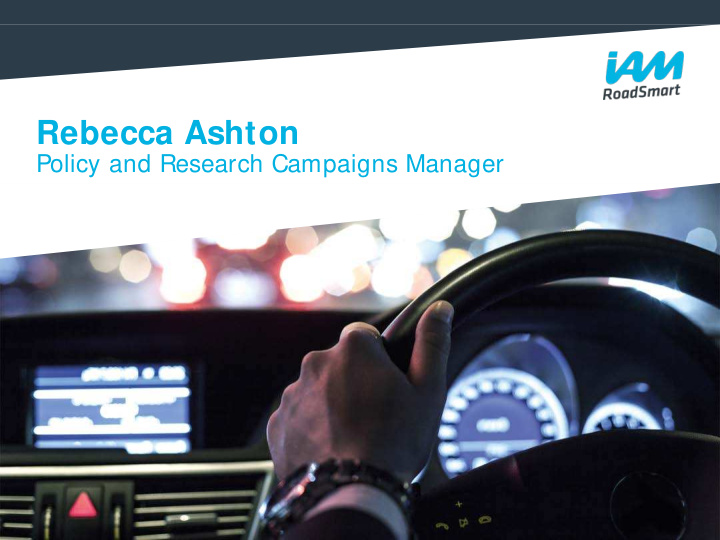



Rebecca Ashton Policy and Research Campaigns Manager
Who are I AM RoadSmart
The 5 key things the I AM is known for • The go-to body for insight on human factors in road safety • An organisation which responds to the needs of Road Users • Expert advisors on how technology and driving aids will enhance and support driving skills • The leading provider of high – quality, independent post – test training for drivers and riders • A charity which has been driving road safety for 60 years
Pedestrian Safety in the UK
UK fatalities by road user type In 2015 there were a total of 1730 people killed • on our roads. 409 of these were pedestrians • 8% less than in 2014 •
Pedestrian facts October to March are the higher months for • pedestrian deaths Urban areas are where most pedestrians are • killed or injured Pedestrians hit on rural roads are more likely • to die
Why are pedestrians killed? • Crossing the road masked by stationary vehicle • Failed to look properly • Misjudged speed or path of vehicle • Misusing crossing • Impaired by alcohol or drugs • Careless or in a hurry • Wearing dark clothing and not being seen at night
Male or Female – who is most at Risk? Pedestrians make up 24% of all road deaths Almost equal split between male and female
Where do we rank on Pedestrian safety in Europe? The UK has a peak in figures when children change from primary to secondary school
Ways to cross the road
How do Pedestrians cross the road • In the UK we have 5 main different types of crossings Zebra Pelican Equestrian Puffin Toucan
How do Pedestrians cross the road • We also have traffic islands and school crossing patrols
Keeping pedestrians safe and traffic flowing • Very busy areas may have subways and footbridges
Pedestrian Safety in the UK
Pedestrian Safety Barriers guiding pedestrians to a dedicated crossing point
What do we do in the UK to help protect pedestrians Tactile paving helps the blind or partially sighted to feel where to cross the road The change in colour and feel can also indicate to other road users where there is a crossing point.
Encouraging space for all 20 zones are meant to help road users share the space, encouraging more walking and cycling Just changing signs is not enough there needs to be other traffic calming measures to get driver to slow down and pay more attention
Local Government – What do they do for road safety?
Local councils and charities provide leaflets and training for children
Can street lighting make pedestrians feel safer? Installing specific pedestrian lighting • This has a great effect on perceptions of place; direct lighting of the footway and makes the street feel welcoming. • Also reduces crime and ‘fear of crime’.
Shared space
Shared space
Shared space
Redesigned space
What does the future hold for Pedestrians?
How can we safeguard pedestrians? Enforcement Engineering Education • Government • City Planners • Pedestrians • Local councils • Road Engineers • Drivers • Police • Car Makers • Riders We need a safe system where all involved work together • Safer Roads • Safer Vehicles • Safer Road Users
Safe Systems • Humans will make mistakes, and the human body has a limit to which it can absorb crash forces without suffering injury. • Safety is a shared responsibility of all actors in a traffic system, not only that of a road user. • All elements of the road traffic system should come together in an integrate safety chain in which the elements will combine to prevent a crash, or at least prevent serious injury, even if one or more elements fail.
What can we do to improve things?
The future of pavements? Are phone walking lanes coming to a pavement near you?
Thank You Rebecca Ashton Policy and Research Campaigns Manager Rebecca.Ashton@iam.org.uk IAMRoadSmart.com
Recommend
More recommend